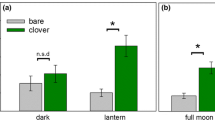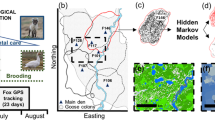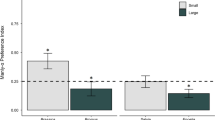Abstract
Predator avoidance may involve response strategies of prey species that are time and space specific. Many studies have shown that foraging individuals avoid predators by altering microhabitat usage; alternatively, sites may be selected according to larger-scale features of the habitat mosaic. We measured seed removal by two small mammal species (Peromyscus leucopus, and Microtus pennsylvanicus) at 474 stations over an experimentally created landscape of 12 patches, and under conditions of relatively high (full moon) and low (new moon) predatory hazard. Our objective was to determine whether predator avoidance involved the selection of small-, medium-, or large-scale features of the landscape (i.e., at the scale of microhabitats, habitats, or habitat patches). We found rates of seed removal to vary more with features of whole patches than according to variation in structural microhabitats within patches. Specific responses included: under-utilization of patch edge habitats during full moon periods, and microhabitat effects that were only significant when considered in conjunction with larger-scale features of the landscape. Individuals residing on large patches altered use of microhabitats/habitats to a greater extent than those on smaller patches. Studies just focusing on patterns of microhabitat use will miss responses at the larger scales, and may underestimate the importance of predation to animal foraging behavior.
Similar content being viewed by others
References
Alverson WS, Waller DM, Solheim SL (1988) Forest too deer: edge effects in northern Wisconsin. Conser Biol 2:348–358
Anderson PK (1989) Dispersal in rodents: a resident fitness hypothesis. Spec Publ, Am Soc Mamm 9: 1–141
Andren H, Angelstam P (1988) Elevated predation rates as an edge effect in habitat islands: experimental evidence. Ecology 69:544–547
Birney EC, Grant WE, Baird DD (1976) Importance of vegetative cover to cycles of Microtus populations. Ecology 57:1043–1051
Blair WF (1943) Activities of the chihuahuan deermouse in relation to light intensity. J Wildl Manag 7:92–97
Bowers MA (1988) Seed removal experiments on desert rodents: the microhabitat by moonlight effect. J Mamm 69:201–204
Bowers MA (1990) Exploitation of seed aggregates by Merriam's kangaroo rat: harvesting rates and predatory risk. Ecology 71:2334–2344
Brown JS (1988) Patch use as an indicator of habitat preference, predation risk, and competition. Behav Ecol Sociobio 22:37–47
Brown JS (1989) Desert rodent community structure: a test of four mechanisms of coexistence. Ecol Monogr 59:1–20
Brown JH, Munger JC (1985) Experimental manipulation of a desert rodent community: food addition and species removal. Ecology 66:1545–1563
Cerri RD, Fraser DF (1983) Predation and risk in foraging minnows: balancing conflicting demands. Am Nat 121:552–561
Dice LR (1945) Minimum intensities of illumination under which owls can find prey on sight. Am Nat 79:385–416
Dueser RD, Shugart HH (1978) Microhabitats in a forest floor small mammal fauna. Ecology 60:108–118
Endler JA (1986) Natural selection in the wild. Princeton Univ. Press, Princeton, NJ
Foreman RTT, Godron M (1986) Landscape ecology. Wiley, New York
Foster J, Gaines MS (1991) The effects of a successional habitat mosaic on a small mammal community. Ecology 72:1358–1373
Fretwell SD, Lucas HL Jr (1970) On territorial behavior and other factors influencing habitat distribution in birds. I. theoretical development. Act Biotheor 19:16–36
Gates JE, Gysel LW (1978) Avian nest dispersion and fledging outcome in field-forest edges. Ecology 59:871–883
Gilliam JF, Fraser DF (1987) Habitat selection when foraging under predation hazard: a model and test with stream-dwelling minnows. Ecology 68:1856–1862
Grant PR (1971) Experimental studies of competitive interaction in a two-species system. III Microtus and Peromyscus species in enclosures. J Anim Ecol 40:323–350
Grubb TC Jr, Greenwald L (1982) Sparrows and a brushpile: foraging responses to different combinations of predation risk and energy cost. Anim Behav 30:637–640
Halama KJ (1989) Of mice and habitats: test for density dependent habitat selection. Unpublished M.S. Thesis. University of Virginia, Charlottesville, Virginia, USA
Hamilton WJ Jr, Whitaker JO Jr (1979) Mammals of the eastern United States. Cornell Univ Press, Ithaca, NY
Harris LD (1988) Edge effects and conservation of biotic diversity. Conserv Biol 2:330–332
Harris L, Skoog P (1980) Some wildlife habitat-forestry relations in the Southeastern Coastal Plain. Proceed Louisiana State Univ Forestry Sympos 29:103–119
Hilborn R, Redfield JA, Krebs CJ (1976) On the reliability of enumeration for mark and recapture census of voles. Can J Zool 62:2440–2444
Holbrook SJ, Schmitt RJ (1988) The combined effects of predation risk and food reward on patch selection. Ecology 69:125–134
James FC (1971) Ordinations of habitat relationships among breeding birds. Wilson Bull 83:215–236
Kareiva P (1989) Reviewing the dialogue between theory and experiments in population ecology. In: Roughgarden J, May RM, Levin SA (eds) Perspectives in ecological theory. Princeton Univ Press, Princeton, NJ
Kaufman DF, Kaufman GA (1982) Effect of moonlight on activity and microhabitat use by Ord's kangaroo rat (Dipodomys ordii). J Mamm 63:309–312
King JA (1968) Biology of Peromyscus (Rodentia). Spec Publ 2, Am Soc Mammalogists
Kotler BP (1984) Risk of predation and the structure of desert rodent communities. Ecology 65:689–701
Kotler BP, Brown JS (1988) Environmental heterogeneity and the coexistence of desert rodents. Ann Rev Ecol Syst 19:281–307
Kotler BP, Brown JS, Smith RJ, Wirtz WO II (1988) The effects of morphology and body size on rates of owl predation of desert rodents. Oikos 53:145–152
Krebs CJ (1966) Demographic changes in fluctuating populations of Microtus californicus. Ecol Monogr 36:239–273
Krebs CJ (1978) Aggression, dispersal, and cyclic changes in populations of small rodents. In: Krames L, Pliner P, Alloway T (eds) Advances in communication and affect. Plenum Press, New York
Lima SL, Dill LM (1990) Behavioral decisions made under risk of predation: a review and prospectus. Can J Zool 68:619–640
Lockard RB, Owings DH (1974) Moon-related surface activity of bannertail (Dipodomys spectabilis) and Fresno (D. nitratoides) kangaroo rats. Anim Behav 22:262–273
Longland WS, Price MV (1991) Direct observations of owls and heteromyid rodents: can predation risk explain microhabitat use? Ecology 72:2261–2273
Morris DW (1987) Ecological scale and habitat use. Ecology 68:362–369
Morris DW (1991) Fitness and patch selection by white-footed mice. Am Nat 138:702–716
Norusis MJ (1988) SPSS/PC+ advanced statistics V2.0. SPSS, Chicago, Illinois
O'Farrell M (1974) Seasonal activity patterns of rodents in a sagebrush community J Mamm 55:217–233
O'Neill RV (1989) Perspectives in hierarchy and scale. In: Roughgarden J, Levin SA (eds) Perspectives in Ecological Theory. Princeton Univ Press, Princeton, N.J
Price MV (1978) The role of microhabitat in structuring desert rodent communities. Ecology 59:910–921
Price MW, Waser NM, Bass TA (1984) Effects of moonlight on microhabitat use by desert rodents. J Mamm 65:353–356
Pulliam HR (1988) Sources, sinks and population regulation. Am Nat 132:652–661
Pulliam HR, Danielson BJ (1991) Sources, sinks, and habitat selection: a landscape perspective on population dynamics. Am Nat 137:S50-S66
Richter-Dyn N, Goel NS (1972) On the extinction of a colonizing species. Theor Pop Biol 3:406–433
Rosenzweig ML (1974) On the evolution of habitat selection. In: Kamil AC, Sargent TD (eds) Foraging behavior: ecological, ethological and psychological approaches. Garland STPM, New York
Rosenzweig ML, Winakur J (1969) Population ecology of desert rodent communities: habitat and environmental complexity. Ecology 50:558–572
Simberloff D (1988) The contribution of population and community ecology to conservation science. Ann Rev Ecol System 19:473–511
Swihart RK, Slade NA (1985) Testing of independence of observations in animal movements. Ecology 66:1176–1184
Stamps JA, Buechner M, Krishman VV (1987a) The effects of edge permeability and habitat geometry on emigration from patches of habitat. Am Nat 129:533–552
Stamps JA, Buechner M, Krishman VV (1987b) The effects of habitat geometry on territorial defense costs: intruder pressure in bounded habitats. Am Zool 27:307–325
Tamarin RH (1985) Biology of new world Microtus. Spec Publ 8, Am Soc Mamm
Temple SA, Cary JR (1988) Modeling dynamics of habitat-interior bird populations in fragmented landscapes. Conser Biol 2:340–347
Thompson DB, Brown JH, Spencer WD (1991) Indirect facilitation of granivorous birds by desert rodents: experimental evidence from foraging patterns. Ecology 72:852–863
Travers SE, Kaufman DW, Kaufman GA (1988) Differential use of experimental habitat patches by foraging Peromyscus maniculatus on dark and bright nights. J Mamm 69:869–871
Turner MG (1989) Landscape ecology: the effect of pattern on process. Ann Rev Ecol Syst 20:171–197
Urban DL, Shugart HH (1986) Avian demography in mosaic landscapes: modeling paradigm and preliminary results. In: Verner J, Morrison ML, Ralph CJ (eds) Wildlife 2000: Modeling habitat relationships of terrestrial vertebrates. Univ Wisconsin Press, Madison
Watts BD (1991) Effects of predation risk on distribution within and between habitats in savannah sparrows. Ecology 72:1515–1519
Wilcove DS (1985) Nest predation in forest tracts and the decline of migratory songbirds. Ecology 66:1211–1214
Author information
Authors and Affiliations
Rights and permissions
About this article
Cite this article
Bowers, M.A., Dooley, J.L. Predation hazard and seed removal by small mammals: microhabitat versus patch scale effects. Oecologia 94, 247–254 (1993). https://doi.org/10.1007/BF00341324
Received:
Accepted:
Issue Date:
DOI: https://doi.org/10.1007/BF00341324




